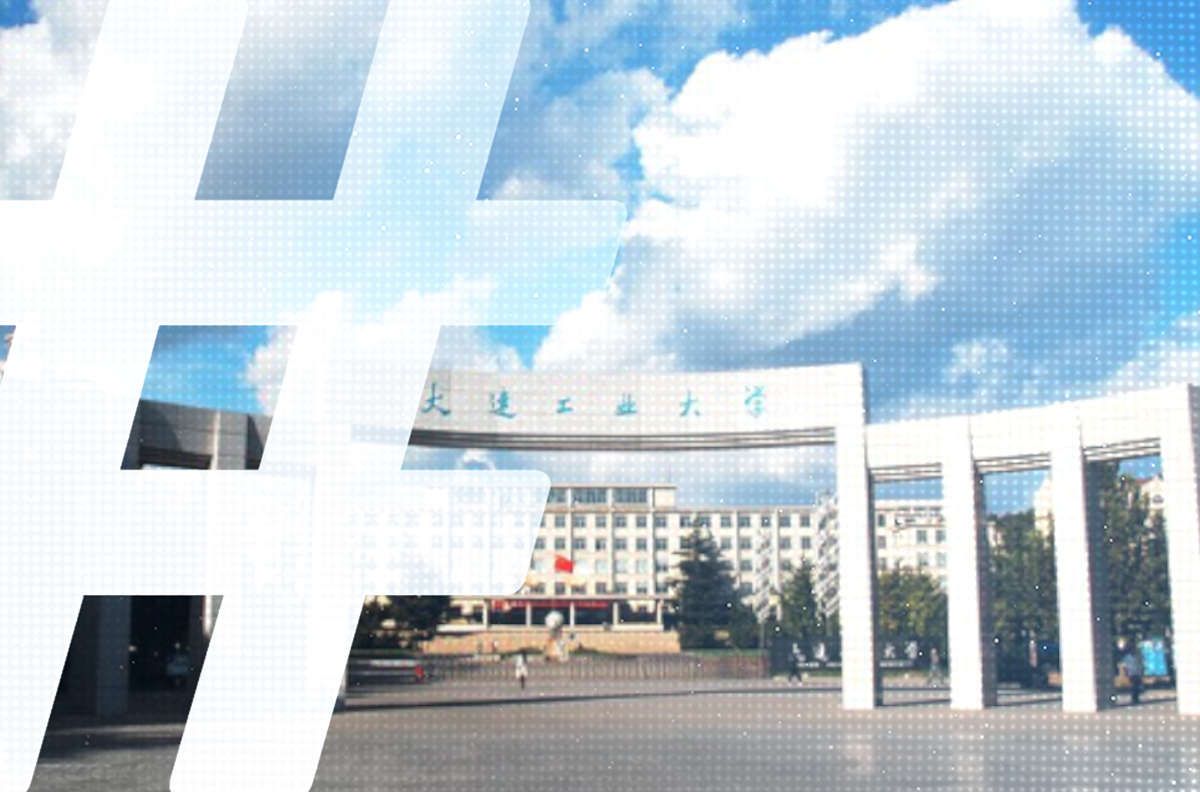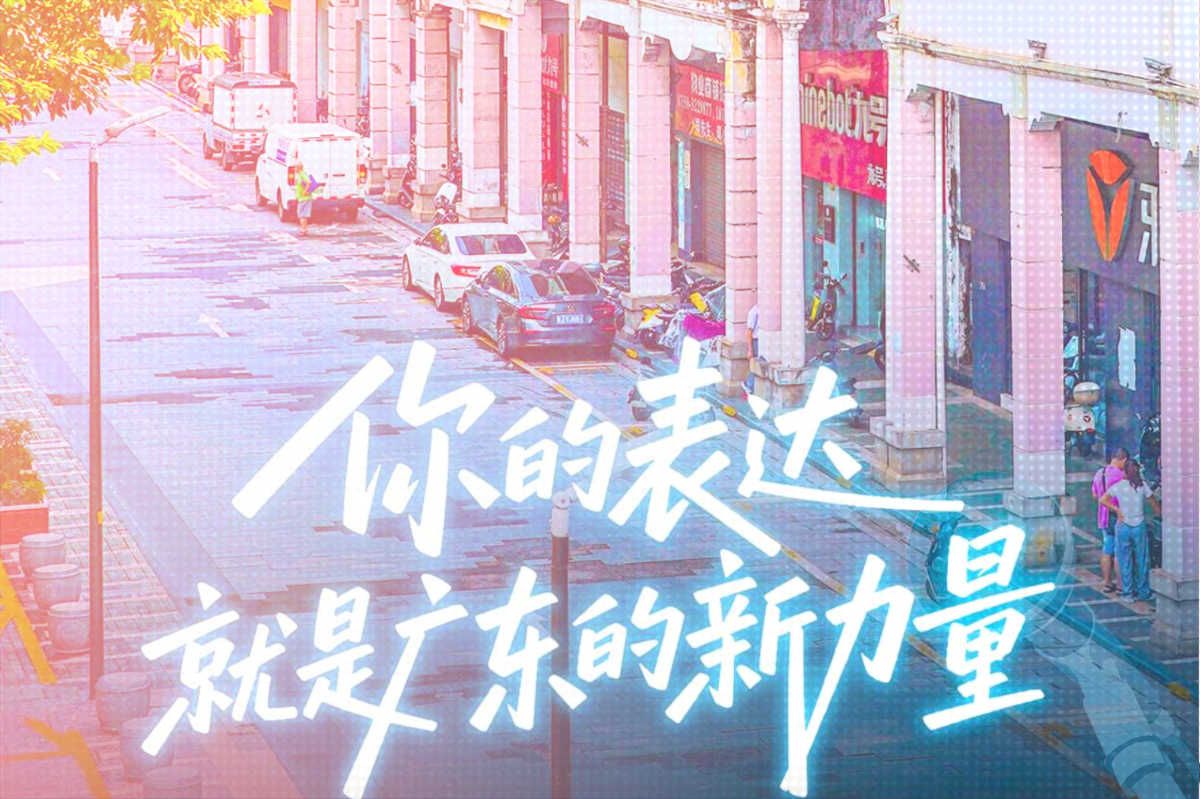Going Global
Inside China’s Global Media Blitz
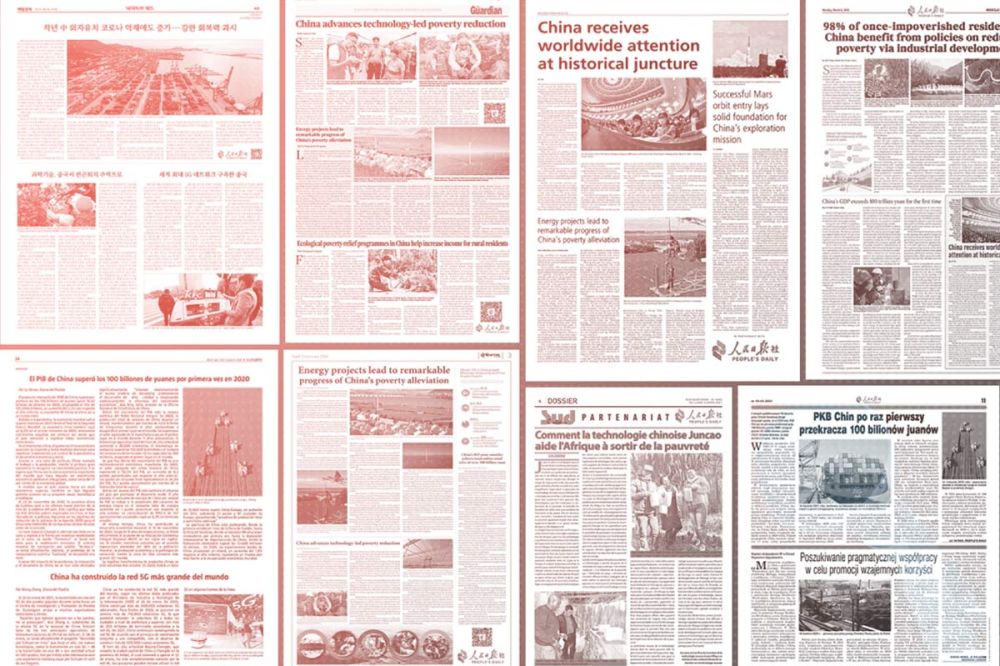
As the fine print of the EU’s trade deal with Beijing became public knowledge late last week, observers quickly scrutinized the text for signs of real progress on “reciprocity,” this being a buzzword that has hummed at the center of so many discussions concerning the EU-China relationship in recent years. As Joachim Lang, managing director of the German industry organization BDI, said ahead of the release of the “market access offers” under the EU-China Comprehensive Agreement on Investment (CAI): “A successful partnership will only work on the principles of reciprocity and establishing a level playing field in competition.”
But there is one sector in particular where China was always unlikely to yield in any way that might appreciably narrow the “reciprocity gap” for investors – and that is the ideological front of the media. The CCP continues to regard the control and direction of public opinion within China, through the vast and evolving machinery of media control, as deeply strategic. The CCP’s dominance and mastery of information is regarded as core not just to maintaining the regime at home, but to shoring up its legitimacy internationally.
This latter aspect of media control, which for the leadership concerns China’s international “discourse power” (话语权), has taken on an ever more prominent role in recent years. And it has frustrated and sometimes infuriated foreign governments in recent months, as China has spread disinformation and sought to downplay international criticism of its handling of the Covid-19 pandemic, all the while playing up what it ever more loudly insists is the superiority of the Chinese political system.
The change in the tone and posture of what CCP still calls “external propaganda” (made over with the slightly more palatable notion of “telling China’s story well”) should make reciprocity in the media a more important topic now than ever.
But as Stuart Lau and Jakob Hanke Vela noted at Politico, media access restrictions remain stubbornly in place when it comes to EU investments in a range of areas. “While European leaders often insist that the deal should achieve ‘reciprocity’ with China, the European Commission conspicuously failed to introduce this logic in the all-important news and information sector,” they wrote of the CAI. “The texts of the accord struck in December show that European investors are boxed out of Chinese media while Chinese investors are largely free to buy up news services, broadcasters, cinemas and film-making ventures in the EU.”
This, they write, means that in terms of soft power, “the tables are firmly tilted in favor of China.”
Bypassing the complex question of how “soft power” – the ability to shape views through appeal and attraction rather than coercion – actually arises and plays out on the international stage, there can be little question that China’s government and Party-state media are taking full advantage of the wide-open spaces offered by freer media environments around the world.
Want proof? Just read today’s edition of the CCP’s flagship newspaper, the People’s Daily.
Page 17 of the paper’s “International” section is a feature on the tremendous inroads the People’s Daily made globally during the recent session of the National People’s Congress (March 5-11). The headline of the feature is, “Injecting Positive Energy Into Global Development,” this talk of positivity being a reference to a key phrase used by Xi Jinping since 2013 to denote the need to limit “negative” information and opinion.
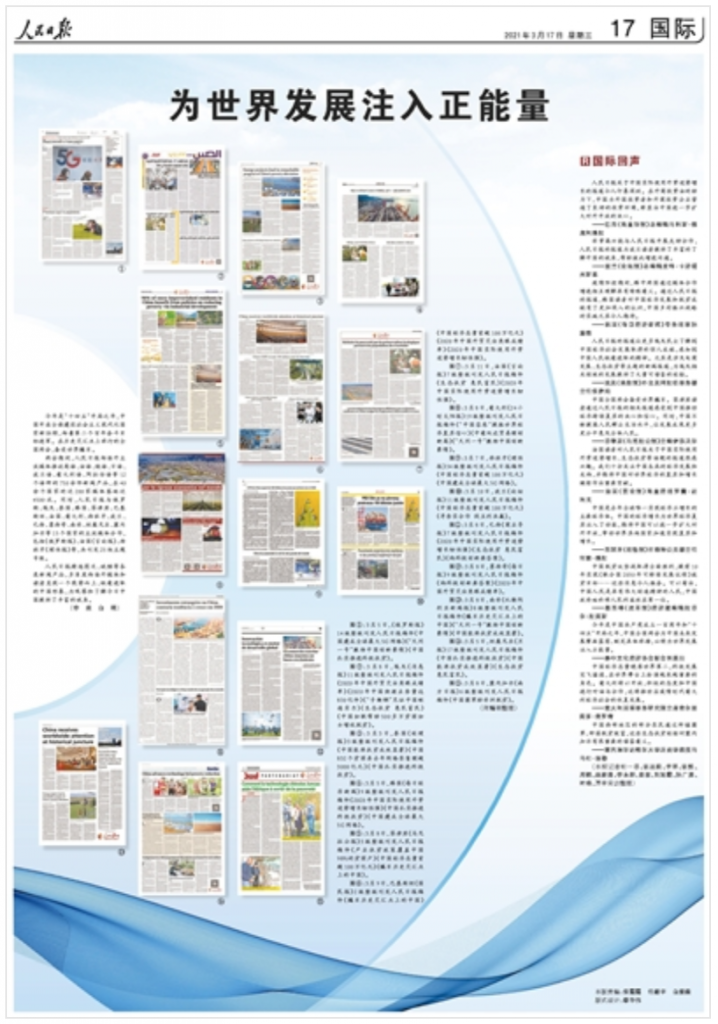
The claims made by the People’s Daily are indeed astonishing. According to the description accompanying 15 full-color page layouts spanning media in Asia, Europe, Africa, South America and Central America, 750 unique articles in 12 languages were successfully placed in nearly 200 media outlets from more than 40 countries, all in the short space of this year’s NPC.
As these articles, generously referred to as “news products” (新闻产品), were often repeated in many languages and publications, this campaign involved close to 4,500 unique instances of what the People’s Daily, referencing professional public relations terminology, called “media drops” (媒体落地).
Languages included English, French, Italian, Polish, Russian, Japanese and Arabic. In most cases, the People’s Daily masthead logo was displayed with the published content, but the fact that these were advertisements for the Chinese Party-state could not have been generally clear for the average reader, assuming a generally low level of China-related literacy.
It was not clear from the People’s Daily feature whether all of the “media drops” were paid for by the Party-state, and the accompanying text suggested that some of the arrangements were through “partnerships.” But the vast majority of the drops would certainly have been paid for, and this would represent a substantial ad buy, running to tens of millions of dollars. Consider, for example, that advertising rates for 2021 posted by the French magazine l’Opinion (one of the publications featured) show that full-page advertisements, depending on placement, run between 18,000 and 30,000 euros, or 21-36,000 US dollars.
When we look at this “media drop” campaign, taking place over just one week this month, in the context of the larger overseas media push by China, which includes entities like the China Media Group (and CGTN) as well as the China Daily and many other channels, we can begin to appreciate the sheer enormity of China’s efforts to overcome what its leadership sees as a global discourse power deficit.
When it comes to soft power, China is pushing hard.
A Glimpse at the NPC “Media Drops”
Let’s look quickly at several of the features and stories the People’s Daily chose to highlight in its “International” section today.
The plug in the French magazine l’Opinion, a pro-business commentary publication that has run pieces in the past from Chinese diplomats, is labelled as a “press release” (communiqué) with a small note in the upper right-hand corner, and includes the People’s Daily logo at the top of the page. The headline of the top article reads: “Reducing Poverty Through Ecological Preservation Allows People to Become Richer.” The second article reads: “Foreign Investment Shows Resilient Growth in China Despite Unfavorable Economic Conditions in 2020.”
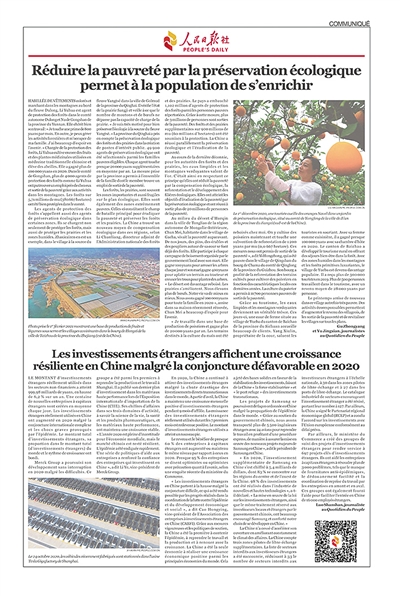
The page in Italian business daily Il Sole 24 Ore, one of the country’s largest newspapers, focusses on economic development and China-Italy trade relations, characterizing China as a “solution” for global economic recovery, and highlighting Chinese innovation (including the Mars explorer Tianwen-1). Headlines include, “Confidence in the Chinese Solution for World Economic Recovery”; and “China-Italy Trade Reaches New Record.” The Il Sole 24 Ore page includes the words “promotional information” in the upper right-hand corner as well as the People’s Daily logo and two QR codes at the bottom right.

Sud Quotidien, an independent newspaper published in Senegal in French, includes the People’s Daily logo at the top of a page of propaganda. However, the page is prominently labelled not as a paid advertisement, but rather as a “partnership” (Partenariat), which would seem to vouch for the credibility of the content as “news.” The headline of the article reads: “”How China’s Juncao Technology is Helping Africa Lift Itself Out of Poverty.”
So-called “Juncao technology” refers to a technique invented by Chinese scientist Lin Zhanxi (林占嬉) – the name a combination of the words for “mushroom” and “grass” – that aids low-cost mushroom cultivation. The technique has been widely promoted by the Chinese government and state media as a form of technological soft power, a means of fighting poverty and desertification.
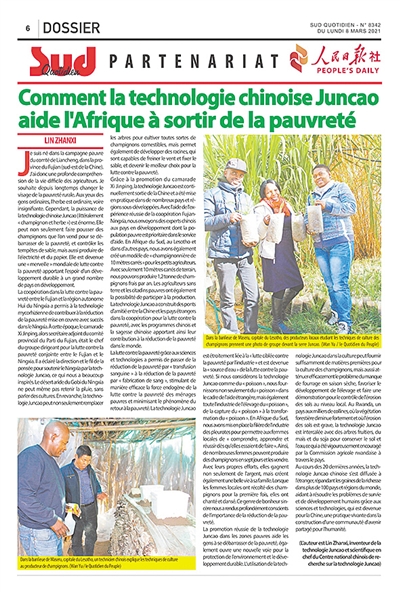
La Jornada, one of the largest newspapers in the Mexican capital, includes a People’s Daily QR code in the lower right-hand corner of the page – but does not otherwise seem to have labelled the content as advertising, or as paid-for by a foreign government. The two articles promote China’s role in driving global economic growth through innovation, the first headline reading: “Technology Innovation is the Engine of Global Growth.”
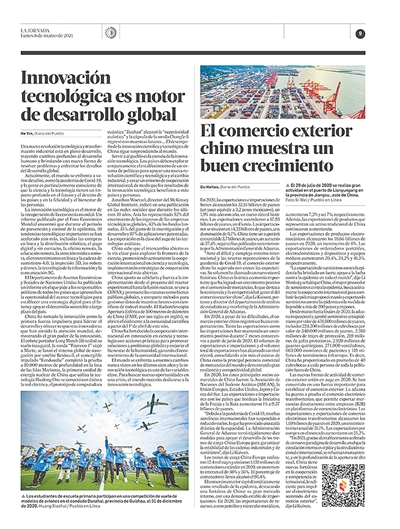
At Brazil’s Monitor Mercantil, a newspaper specializing in economics, business, and politics, the page from the People’s Daily does not seem to be labelled at all as content from the Chinese Communist Party’s flagship newspaper. Rather, it is labelled at the top as “international” coverage, and a small note at the bottom of the page notes that it is a “special project of Monitor Mercantil.” Headlines include: “Foreign Investment in China Goes Against the Trend and Grows in 2020”; “Alleviating Ecological Poverty Enriches the Population”; and “Technological Innovation is the Driving Force of Economic Recovery.”
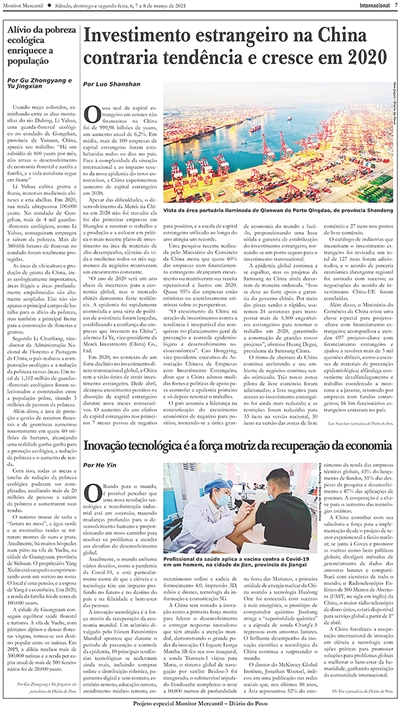
A translation of the introductory text to today’s People’s Daily feature on NPC coverage dropped in overseas media.
____________
[Translation]
Injecting positive energy for world development
People’s Daily
March 17, 2021
This year is the opening year of the 14th Five-Year Plan, and China is beginning a new journey to build a comprehensive socialist modern country and marching towards the second centenary goal. The national two meetings [of the NPC and CPPCC], held at the crossroads of history, have drawn the interest of the world.
During the two sessions, the People’s Daily pushed more than 750 news products into overseas mainstream media in 12 languages, including English, French, Russian, Japanese, Polish, Italian and Arabic, landing nearly 4,500 times in close to 200 media outlets in more than 40 countries. Meanwhile, the People’s Daily cooperated with mainstream media in 15 countries, including Russia, Egypt, Thailand, Korea, Philippines, Pakistan, France, Italy, Spain, Poland, Brazil, Mexico, South Africa, Tanzania and Senegal, including the Russian newspaper Rossiyskaya Gazeta, the French newspaper l’Opinion, and the Spanish newspaper La Razón, and published 25 thematic special editions.
People’s Daily selects various news products such as graphics and videos, presenting overseas media and readers with a multi-angle image of China that rides on the momentum and forges ahead, providing a rich perspective for observing and understanding China today.
(Li Yan, Bai Yang)
Layout design: Cai Huawei

















